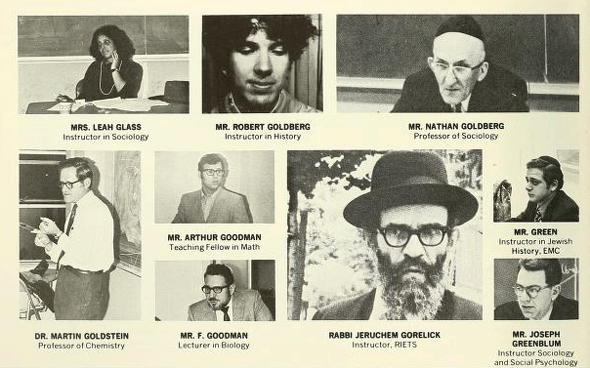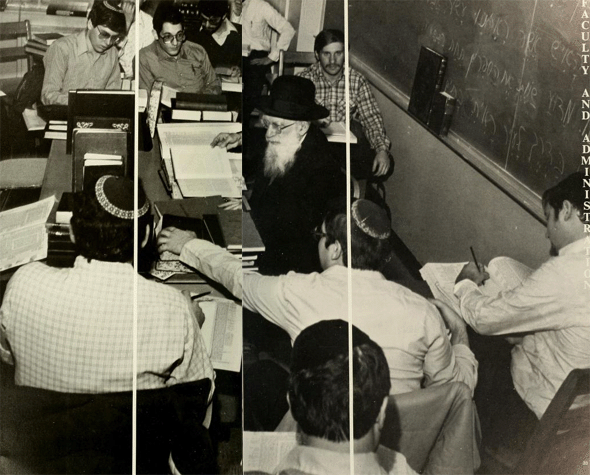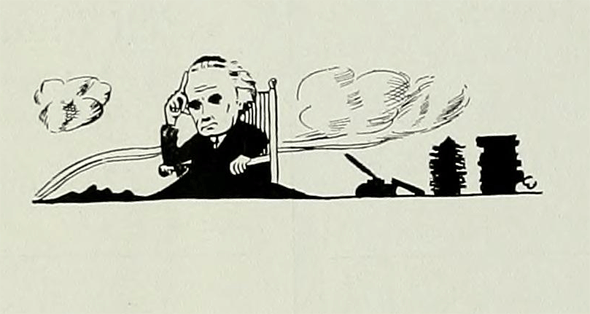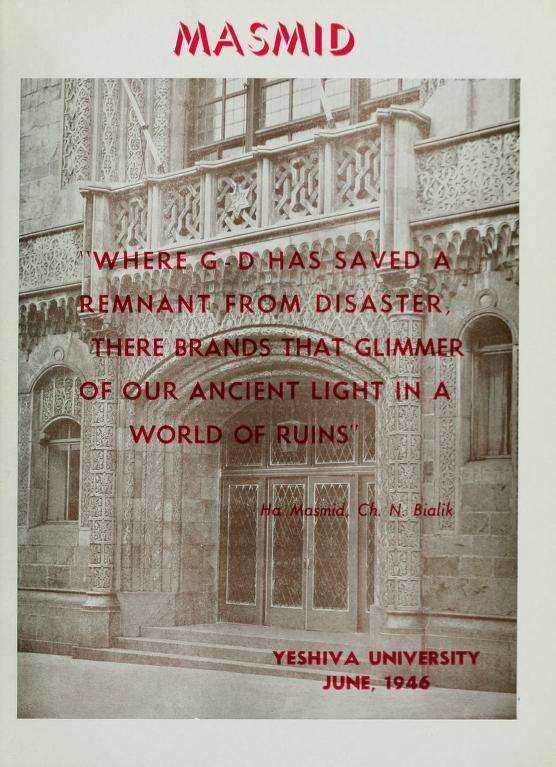I'm sure a lot of gems could be found in those pages which are a snapshot of an important part of American Orthodox history in the 20th century. I haven't had the chance to look through them thoroughly yet, but I did see a few interesting things. Watching the changing looks of the students is interesting. Looking through them you may be able to tell when Rabbi Moshe Tendler turned into Rabbi Moses Tendler (in earlier issues he was Rabbi Morris Tendler, which I bet it what's on his birth certificate) and what if anything that says about changes in our society.
In one earliesh yearbook there is an article by legendary American rabbi Bernard Drachman (perhaps best known today for his translation of Hirsch's Nineteen Letters) about how American Jews should learn German, as that's really the lingua franca of Jews worldwide (he goes on to opine that Yiddish is really a dialect of German, so it counts, and that means that 10 million Jews already speak German).
It's also interesting how, apparently, in the earlier issues the yearbook was very much for the College part of the yeshiva, and the Yeshiva part was just not mentioned very much (although of course there's plenty of Jewish and Torah content). As time goes on, there seems to be much more integration, and that is when photos of the rabbeim start to appear.
Naturally the Rabbi Soloveitchik treatment is interesting and deserves to be looked at carefully. Some years he is Rabbi, others Harav and one year he is even Dr. (Harav seems to have been what wins out; all the other rabbeim are titled Rabbi.) By 1974 they appear to be have been very . . . into "the Rav." Below is a full two-page spread. But bear in mind that it was only two years before that his picture was captioned "Dr.," which leads me to suspect that much of the content reflects particular editors and available artistic talent more than moods and currents of the time.

Detail:


And a much more restrained image from 1976:

Here are some pictures of Rabbi Yeruchem Gorelick, who of course never taught Talmud at RIETS:
1972:

1977:

Here's a really nice picture of Rabbi Dovid Lifschutz giving a shiur (1983):

Below is a picture of the recently deceased Dr. Bernard Lander in his 1936 yearbook:

You may have noticed that I am trying to avoid violating anyone's privacy, so outside of well known individuals I'm not going to post your or your father's picture with a big afro or acting in "Guys and Dorms" (an actual play they put on in the '50s) along with a name, but I'll make an exception here. Below is an entry from 1948 from a guy who obviously really loved to learn:

A notable talmid (1953):

1948 being an important year in modern Jewish history you'd think there'd be a lot about Israel (there's mention of two students who died fighting in Palestine). There isn't, but there are three essays about Torah and science. There's "The Jewish Dietary Laws Verified by Science" (name withheld so as not to embarass). There's "Criteria in the Resolution of the Conflict Between Science and Halacha" by Norman Lamm, and there's "Science and Religion in the Modern Age" by Charles Siegel. Maybe the issue was edited early (Israel independence being declared in May and all). Still, I wonder what's up with all the Torah and science in 1948.
For some unexplained reason, the following little doodle appears on the last page of the 1933 edition of the Masmid:

The 1939 number had an article about students who were refugees from Hitler. After the Iranian Revolution one can see that there were many students who were refugees from Khomeni. Below is from the 1946 issue, which is poignant coming as it does on the heels of the Holocaust (and interesting because it does the G dash d thing. This is 1946, so now you know that it was already being done in 1946. Who knows, this may the only time in history anyone ever quoted Bialik with "G-d"):

This is not even scratching the surface. It's kind of strange to come across so many people I know through their accomplishments (brainiac Nat Lewin was valedictorian of his class) or even know personally, including some who I never knew went to YU, and probably in some cases it isn't by accident (you're totally busted). In case anyone is wondering, Rabbis Avigdor Miller and Rabbi Nosson Wachtfogel may have been spared from being immortalized on the pages of the Masmid, although if they were not I'll find out (Rabbi Wachtfogel's brothers are certainly there).
Anyone who is interested in 20th century American Orthodox (men) in general or Yeshiva University specifically would do well to have a look at these.

A few points should be made:
ReplyDelete-Yeshiva College, whose yearbook the Masmid is, was considered entirely separate from "The Yeshiva" for many years- I'm not talking about the 1970 legal separation, but the practical aspects of the 1928-1970 YC. YC students could be *either* "Yeshiva" or TI students (although TI ran for only six years, so TI students joined the Yeshiva for their last two), and the yearbooks reflect this. My father's 1958 Masmid shows the Roshei Yeshiva not at all; it does show the Jewish Studies faculty of YC (of course, there was overlap).
-Immediately after the Holocaust, Louis Bernstein had an interesting short story about the galut. Have to find that one...
-People like R's Miller, Wachtfogel, Schienberg, and Gifter were there mostly pre-1928, so no Masmid for them.
-I have to look up the one year (late 60's) it was the "Matmid," with a vinyl folder containing multiple little pamphlets.
I wonder if they'll put up MTA and BTA yearbooks (Elchanite) as well.
The 1971 Masmid is one for the ages. I wonder if there an uncensored version will find its way online...
ReplyDelete>People like R's Miller, Wachtfogel, Schienberg, and Gifter were there mostly pre-1928, so no Masmid for them.
ReplyDeleteAh, they were there in high school. Got it.
Menachem, don't be so mysterious. Please do tell.
No, they were in RIETS, but YC didn't exist yet. I don't think they were in YC, although some of them may have been, if they were born after 1920 or so.
ReplyDeleteFound them! The "Matmid," with the unique layout, is 1972. Bernstein's story is "Only Bondage in Exile," 1946. "Ninety Percent," the story before, is good too.
Sorry, born after 1911 means they could have been in the first graduating class of 1932.
ReplyDeleteI realize they didn't graduate (possible exception is R. Gifter?) but if they were undergrads at all then possibly they'd be in them as, at least in those days when the student body size was so small, the lower classes are usually depicted.
ReplyDeleteS, did you mean to write Levovitz, or Gorelick?
ReplyDelete--Phil
The latter Phil. Thanks for the sharp eye.
ReplyDeleteWhat's the "Yeshiva students' national anthem called Matara"? Do you have any information about this?
ReplyDeletei'm waiting for some ambitiously polemical person to go through and compile a list of all the yu grads who went OTD
ReplyDeleteWell, 29-88 are up. (I recall the library's collection petering out after that anyway.) Exceptions: 62, 63, 78. Maybe today...
ReplyDeleteYes, Menachem, even 71, which seems pretty much unedited. There is a blacked out line at one point which seems to be a typo. A lot of what we'd consider "objectionable" certainly made it in. It *was* 1971.
The dearth of Israel coverage in 1948 and the emphasis on "Torah and science" may be at least partially explained by the fact that the dean of YC at that time was Dr. Moses L. Isaacs, my grandfather. At the time he was a staunch anti-Zionist (although he later mellowed), and he may have had some editorial influence over the yearbook, notwithstanding that his position was unpopular with the student body. He was also a chemistry professor throughout his career at YU (he retired from Stern College in 1967) and had a particular interest in the Torah-and-science issue; he saw the so-called conflict as a false one. Some of his essays on this subject appeared in various volumes of R. Leo Jung's "Jewish Library" series and make good reading even now.
ReplyDeleteThe 1933 doodle looks to me like Dr. Samuel Belkin, later YU President.
Thank you for not showing my graduation picture!
Nachum,
ReplyDeleteI have an uncensored copy-I really have no idea how I got it (I was '73).
KT
Joel Rich
S,
ReplyDeleteThere was an interview with Harav David Berger that for some reason was found objectionable. Believe me, if you were there then, you'd laugh at what was in the article vs. what was going on on campus and in the world.
KT
Joel Rich
Joel- what pages?
ReplyDeleteI'll look when I get home.
ReplyDeleteKT
Joel Rich
>The 1933 doodle looks to me like Dr. Samuel Belkin, later YU President.
ReplyDeleteNo when he still a boychik in 1933!
1971 is missing a number of pages, from 34 and on, around 5 pages. What was so objectionable?
ReplyDelete>i'm waiting for some ambitiously polemical person to go through and compile a list of all the yu grads who went OTD
ReplyDeleteHa. Actually I thought it might be fun to find and post the picture of the most and least "yeshivish" looking graduate in every issue.
OK, S., you may have a point about Dr. Belkin's boychikhood in 1933. The only other faint possibilities I can think of to ID the doodle are Einstein and Brandeis, but in either case the depiction of a yarmulke would most likely have been tongue-in-cheek.
ReplyDeleteBen Gurion, I thought.
ReplyDeleteLawrence Kaplan
ReplyDeleteLook at the 1965 Yearbook-- my graduating class. There the name of the the Rav is attached to the picture of his brother, and vice versa!
Lawrence Kaplan
ReplyDeleteNachum: Ben-Gurion was the first person that occured to me as well- for what it's worth.
34-37 is the Rav Berger interview
ReplyDeleteKT
Joel Rich
All right, I'll go with B-G. It does look like a photo I found of him from 1933. But what's with the kipa?
ReplyDeleteSurreal image popped into my head when checking this out: Theodore Adams transposed onto the set of "Glee." (he apparently was the head of Glee Club)
ReplyDeleteRav Gorelick certainly taught Talmud at Yeshiva - first in high school level sheurim and later in college level sheurim. His biting, sardonic wit was legendary.
ReplyDeleteYes. Check the story in the 1946 yearbook by Osher Kahn, for example. Not to mention the cover page above. Until 1967, it wasn't really discussed- see the introduction to the last section of the Soncino Talmud, which uses similar circumlocutions.
ReplyDeleteThe line about R' Gorelick is a joke- his son (and others) recently denied that he taught at YU.
Ben Gurion, in a famous incident involving Leo Jung, *did* wear a kipah when he came to YU, but that was years later.
Who is this "Rav David Berger?"
Some blacking out off text about the Dean in the 1974 issue page 106.
ReplyDeleteNachum,
ReplyDeleteI think you can find him now in the Dean's office at BRGS :-)
KT
Fascinating, fascinating. I quickly perused the 1942 issue and noted the complete absence of anything regarding the Jews of Europe. While the enormity of what was going on at that time had not become public, it was obvious in 1942 (indeed since the 1930s) that the Jewry in Europe was in grave danger. Maybe our expectations of student activism and social consciousness is a bit anachronistic, but still.
ReplyDeleteI see I unknowingly echoed a comment above. Upon further browsing, it appears that the 1944 issue does feature events in Europe more prominently -- the cover features a gold Star of David and there is much discussion of the war throughout the book.
ReplyDeleteAlthough these publications are fascinating artifacts of a their time and place, we should be cautious about reading too much into them -- to a great extent they reflect the interests of those that happen to be the editors that year.
"The 1971 Masmid is one for the ages. I wonder if there an uncensored version will find its way online... "
ReplyDeleteUmm, I see one. I'm reading the intro, I see what you mean.
Aharon Lichtenstein
ReplyDelete"From the mouth of babes ofttimes comes gems"
His nickname was "the Babe"
Class of 1951
ReplyDeleteNORMAN TWERSKY Philosophy
Pres. LR.S. 50-51, Economics Club,
Deutscher Verein, Placement Service
Did he become a Rebbe?
>i'm waiting for some ambitiously polemical person to go through and compile a list of all the yu grads who went OTD
same can be done with Chaim Berlin and TV graduates
From Lawrence Kaplan:
ReplyDeleteRe Rav Gorelick: His son was modeh that he taught at Riets, but supposedly only mahshavah, not-- chas ve-shalom -- Gemara. Also nonsense.
I agree with Nachum. What's with the "HaRav David Berger." I am certain that Rabbi Professor Berger would find it embarrassing.
Well if you don't like Harav, then the correct title is "Herr Professor Doktor" (just ask him!)
ReplyDeleteKT
Joel Rich
what happened to the Rav Soloveitchik interview-it's not in my original 1971 masmid nor online?
ReplyDeleteKT
Joel Rich
DF
ReplyDeleteAre there no Torontonians reading this? Henry Hoshander (the rishonim guy) was a pretty prominent rabbi in a prominent Toronto Modern Orthodox shul, Sharrei Shomayim, for a long time. He was succeeded by Mark Dratch, if I'm not mistaken.
DF
My late father-in-law, Rabbi Dr. Aaron Baer,ZT"L,of the class of 1943 is mentioned in that year's Masmid. Our family was grateful to find it online as we no longer have the original.
ReplyDeleteRav Mordecai Gifter, then known as Max, was eight years old when YC opened its doors. He attended (I believe in 1939) for a total of one semester. He did not have a college degree (though few professors of English could match his command of the language).
ReplyDeleteIt may be true that Rav Ahron L was referred to as the babe but my father had never heard that. He did however comment that Rav Ephraim Steinberg was referred to as the the babe.
ReplyDeleteMy name is Leah Siskin, Wellington , Florida. I am trying to locate Rabbi Henry Hoshander formerly of Rochester,New York. I heard recently that he may have moved to Israel. Any contact information would be much appreciated. phil@philandleah.com. It is quite important. Thank you.
ReplyDelete